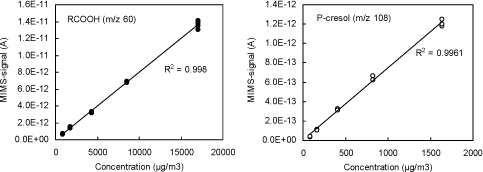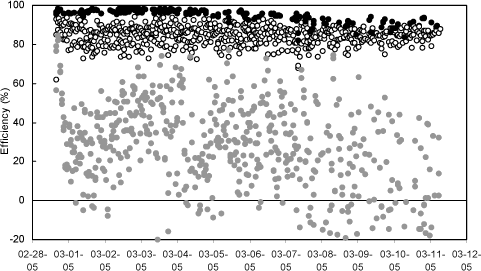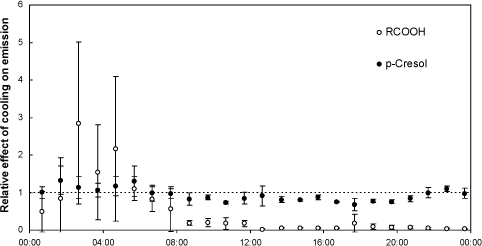Udvikling af måleteknik for optimering og beskrivelse af lugtbegrænsende teknologier til husdyrbrug
Summary and conclusions
New chemical measurement techniques to evaluate odour problems and odour reduction have been tested in relation to odours from pig production. Membrane Inlet Mass Spectrometry (MIMS) has proven to be a useful online measurement technique for odour compounds. This technique is applicable for optimization of odour abatement technologies and for documentation of temporal variation. By supplementing MIMS with GC/MS and GC/O analyses, valuable detailed information about the occurrence and significance of odour compounds can be obtained.
Background
Odour nuisance from animal production is an increasing problem in many communities due to intensified livestock production. Especially pig production causes odour nuisance both from livestock buildings and from management and application of manure. This is probably a result of a combination of intensive production and the presence of particularly offensive odour compounds. As a consequence, economically realistic technologies for reducing odour emission from pig facilities are currently being developed. This development is primarily being carried out by small private enterprises supported by agricultural organizations and with the help of public and private knowledge institutions.
In order to develop efficient odour abatement technologies, it is necessary to have access to objective measurement methods for documentation. In a development and optimization process it is furthermore necessary to obtain fast and accurate evaluations of the changes implemented by the technology.
Traditionally, odour is measured by a so-called olfactometric analysis. This method is based on human nasal perception and involves an odour panel of typically six individuals. These are exposed to various dilutions of air sampling in special sampling bags. Based on this, an odour threshold is determined, which is defined as the dilution factor corresponding to the level at which the odour can be detected by 50 % of an average population. The method is relatively complicated and resource-consuming and is furthermore associated with great uncertainty since it is based on a subjective judgment.
As a consequence of the limitations of the olfactometric approach, initiatives towards development of new and more objective methods for measuring odour have been instigated. In this project, the measurement technique MIMS (Membrane Inlet Mass Spectrometry) has been further developed and tested as an online method for fast and reliable detection of characteristic odour compounds from pig facilities. In addition, gas chromatography with mass spectrometric detection (GC/MS) and gas chromatography with olfactometric detection (GC/O) has been used for supplemental measurements.
Course of the project
This investigation has been coordinated with ongoing tests of odour reduction initiated by the Danish National Committee for Pig Production. The technologies tested consist of biological air filtration, cooling of ventilation air, and application of a feed additive.
Initially, the measurement techniques have been compared with respect to artificial odour samples consisting of known odour compounds from pig production.
Subsequently, a total of five measurement campaigns with duration of 1 to 4 weeks have been carried out in which continuous MIMS-measurements have been undertaken together with point samples analysed by the other techniques.
MIMS measurements together with a limited number of GC/MS measurements have been performed by the Danish Technological Institute, while the Danish Meat Research Institute has carried out the rest of the GC/MS measurements as well as GC/O analyses and the National Committee for Pig Production has been responsible for practical tests as well as olfactometric analyses, which have been carried out by the odour laboratory at the Danish Meat Research Institute.
Main conclusions
The project has focussed on development and evaluation of MIMS as an analysis tool in relation to reduction of odour. The results obtained in the project demonstrate that MIMS is useful for measuring most of the odour compound groups present in odour emissions from pig facilities.
Certain structurally related compounds are measured as a common parameter. MIMS measurements can therefore be used for obtaining online results of the effect of an odour reduction technology on compound groups or individual compounds.
The instrument has turned out to be sufficiently robust to be used onsite as a field instrument in animal production facilities.
Results obtained with MIMS are in good agreement with concurrent results obtained with GC/MS with respect to estimation of odour reduction.
A statistically significant correlation between the measured reduction in odour intensity and odour intensity estimated from MIMS measurements has been observed. The MIMS results cannot explain all of the odour reduction measured olfactometrically, but in light of the well-known uncertainty associated with human perception of odour, the results must be regarded as promising.
GC/MS gives a reliable specific compound identification and quantification but cannot in ots present form be used continuously onsite. Certain compounds, particularly dimethyl sulphide and methyl-mercaptan, cannot at present not be sampled quantitatively for GC/MS measurement.
GC/O-analysis based on olfaktometric detection of odour compounds in a complex mixture gives very valuable information about the significance of single odour compounds when isolated from the complex matrix.
In the initial basic studies, a reduction in odour intensity was surprisingly not seen, even for large dilutions of a synthetic mixture of odour compounds. The results showed reproducible results for samples analysed by olfactometry on the same day by the same odour panel, whereas for identical samples analyzed on different days by different odour panels, there was a quite large amount of variation.
Project results
Basic studies of MIMS response to odour compounds
In the initial phase, the response of the MIMS instrument towards mixtures of selected odour compounds was investigated. It was demonstrated that several of the major MIMS signals can be assigned to important odour compounds or structurally related groups of compounds. Some signals are less specific and therefore less useful for monitoring odour compounds. The composition of the samples was confirmed by GC/MS.
There are a number of carboxylic acids present in typical samples from pig facilities. These give rise to overlapping MIMS-signals at m/z 60, 73 and 74. Therefore carboxylic acids are mainly measured as groups of compounds according to these signals. Likewise, reduced organic sulphur compounds are detected by a common signal at m/z 47, corresponding to compounds containing the CH3S moiety, which mainly comprises methyl mercaptan, dimethyl sulphide and dimethyl disulphide. These sulphur compounds give rise to other MS fragments that are not, however, unambiguous due to overlapping with other compounds. Other odour compounds, like skatol and indol, possess more specific MS signals.
The sensitivity of MIMS is compound-specific and is related to the volatility and polarity of the compound and hence its ability to be absorbed into the non-polar membrane. Carboxylic acids, for example, are highly abundant (as quantified by GC/MS) but do not give rise to the largest MIMS signals due to their high polarity.
An important feature of MIMS is the linearity of the response as a function of concentration. In Figure 0.1, examples of calibration curves for carboxylic acids (RCOOH; the sum of carboxylic acids containing the mass spectrometric fragment with m/z 60) and p-cresol (4-methylphenol) are shown. The data in Figure 0.1 was obtained by injecting various amounts of a synthetic mixture of 10 important odour compounds into a Tedlar sampling bag and analyzing by MIMS. The concentration levels were selected in order to cover real-world concentration levels.

Figure 0.1 Calibration curves of RCOOH (carboxylic acids) and p-cresol. The straight curves are linear regression data.
Application of MIMS for monitoring odour reduction
An example of results from the application of MIMS for monitoring the efficiency of a biofilter is presented in Figure 0.2. It appears that the efficiency of the filter towards different compounds is quite stable, whereas there is more variation regarding the efficiency towards different types of compounds. P-cresol and carboxylic acids are efficiently removed, whereas organic sulphur compounds are less reduced and with much more variability in the results. These results are not surprising since a prerequisite for efficient removal is that the odour compounds are absorbed into the aqueous phase of the biofilter. Organic sulphur compounds, such as dimethyl sulphide, are much less water soluble than carboxylic acids or p-cresol.

Figure 0.2 Biofilter efficiencies towards p-cresol (black circles), RCOOH (open circles) and reduced organic sulphur compounds (ROS; grey circles). Data from March 2005. The efficiency is estimated from the MIMS signals before and after the filter.
Another example of application of MIMS is presented in Figure 0.3. In this case, the effect of cooling ventilation air on odour emission was investigated. Two pig stable sections were compared. In one section, the intake ventilation air was cooled in order to reduce the ventilation rate to about 50 %, whereas the other section had a normal ventilation rate. In Figure 0.3, the relative effect of cooling on the emissions of carboxylic acids and p-cresol are presented as the average diurnal variation of the measurement period of four days. A relative effect of <1 corresponds to a reduction in the emission caused by cooling.

Figure 0.3 Average diurnal variation of the relative effect of cooling ventilation air on the emissions of carboxylic acids (RCOOH) and p-cresol. A relative effect of <1 corresponds to a reduction caused by cooling. Error bars represent the variation in the data.
The effect of cooling on p-cresol is relatively small, with a small reduction during daytime and small increase during night time in the section with cooling. Contrary to this, emission of carboxylic acids was significantly reduced during daytime and evening, but was more strongly increased during night time, although the variability in the data is quite large. The mechanisms behind these patterns cannot be elucidated from the current work, but the results demonstrate the ability of continuous measurements to demonstrate temporal variations that cannot be observed from single samples for olfactometric analysis or laboratory chemical analysis.
Comparison with olfactometry
A dataset consisting of olfactometric measurements and MIMS measurements was subject to multivariate statistical analysis in order to attempt to elucidate a statistical relationship between odour reduction observed by olfactometry and odour reduction predicted from MIMS measurements. The analysis was based on 23 data points from 3 different types of abatement technologies and resulted in a correlation coefficient (R²) of 0.56. Although this is statistically significant (P<0.001), it is also clear that a more extensive dataset is needed for this purpose. Part of the difficulty with this approach is the inherent uncertainty associated with olfactometry.
Version 1.0 August 2006, © Miljøstyrelsen.